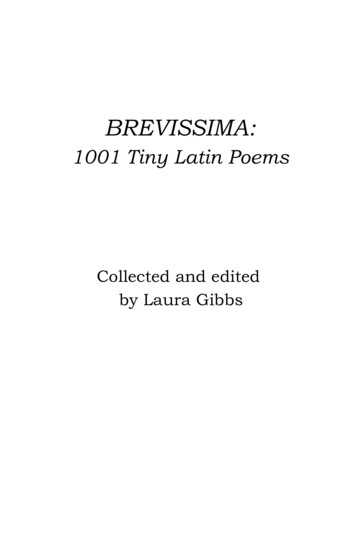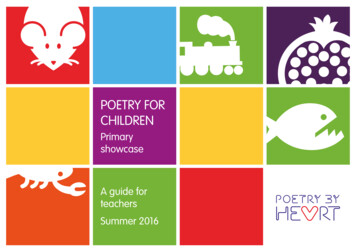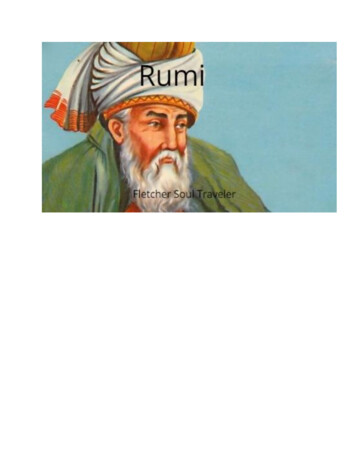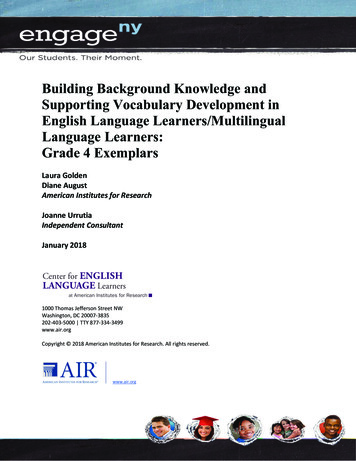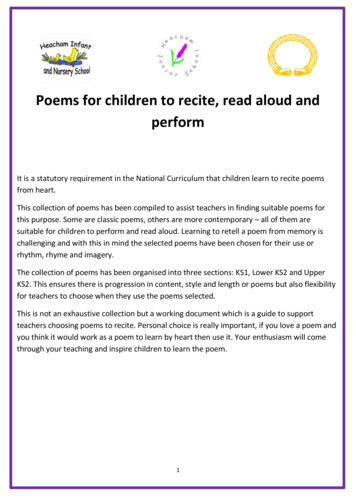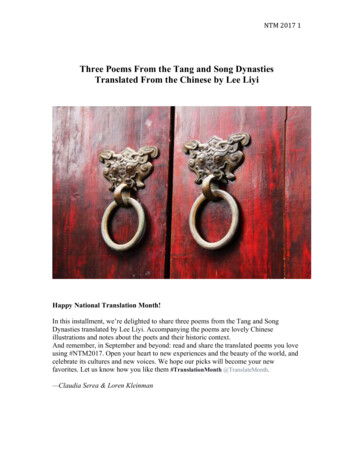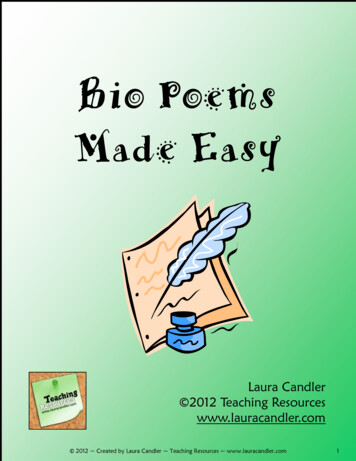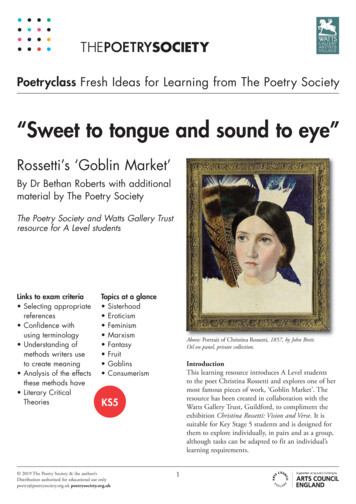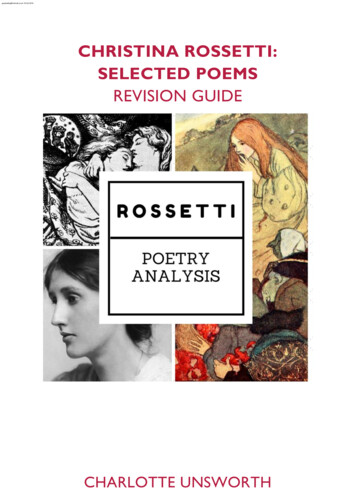
Transcription
guydowling@hotmail.co.uk 19 Oct 2016CHRISTINA ROSSETTI:SELECTED POEMSREVISION GUIDECHARLOTTE UNSWORTH
guydowling@hotmail.co.uk 19 Oct 2016For more analysis and guides, go to www.charlotteunsworth.comCONTENTSWhat to expect in this guide . 3About the author of this guide . 3Assessment objectives: . 4List of Selected poems for study. 5Birthday . 6Echo . 9From The Antique . 12Good Friday . 16Goblin Market . 19In the Round Tower at Jhansi . 24Maude Clare. 28No, Thank You, John . 34Remember . 38Shut Out . 42Soeur Louise de la Misericorde . 47Song: When I am Dead . 52Twice . 55Uphill. 60Winter: My Secret . 63Practice questions . 69Context . 70Family History . 70Marriage and Relationships. 71Beliefs about women’s role in society including work with fallen women . 71Politics . 73Religion. 73Rossetti’s writing and literary influences . 73Critical viewpoints. 74Glossary . 76Form and metre . 76Structure . 77Language. 77Goblin Market – full text . 792
guydowling@hotmail.co.uk 19 Oct 2016For more analysis and guides, go to www.charlotteunsworth.comWHAT TO EXPECT IN THIS GUIDEFor each poem you’ll find: The poem itselfContext to help explore the poemStanza by stanza annotation of thematic interpretation and language analysisAdditional analysis of structure and formKey connections (theme and motif) with the rest of the collectionThis is primarily an AS-Level guide, because it doesn’t compare to other texts, but has elementsuseful for the A-Level as well. For example, assessment criteria and objectives, as well as sampleanswers, are AS-Level focused. The interpretation of poems serves for both levels.There’s also some critical interpretation for many of the poems. While this is specifically assessedat A-Level (AO5), it can also be useful to make brief reference for AO1 at AS-Level, so it is helpfulto include.You won’t find a single, straight-forward interpretation – I don’t believe that Rossetti’s writing lendsitself to such! Instead, I think Rossetti is often writing consciously, and there are several obviousthemes. I also think there’s some themes where we have to question how consciously Rossettiherself is exploring ideas – but that doesn’t mean that they aren’t present. Rossetti’s poetry, for me,is full of doubt and religious conviction, complex considerations of women’s rights and independentthinking, and a difficult relationship with sexuality. How much of that was in Rossetti’s mind, I haveno way of knowing – but as an A-Level student, one of the best things you can do is search for thecomplexity of meaning and acknowledge that literature speaks to different people of different things– even the writers themselves.ABOUT THE AUTHOR OF THIS GUIDEI’ve been teaching English Literature and English Language for more than six years in my job asCurriculum Leader at one fo the top performing state schools in the North of England. We’ve beendoing the new OCR spec, and I love the Rossetti collection they’ve included! She’s a fantastic poet,with an incredibly depth which you don’t always see at first glance – she’s famous for a handful ofpoems popular at weddings and funerals, and the carol It Came Upon A Midnight Clear. But once youlook into it there’s just so much to explore, and my hope for this guide is that it gives you theconfidence to understand the poems, and to form your own opinions and judgments as well.By writing mini-essays of analysis, rather than labelling sections, I’m also showing you what I thinkgood analytical writing looks like; not over-laden with terminology when it’s not useful, but using aprecise and detailed interpretive style. I’m happy to answer questions on my blog atwww.charlotteunsworth.com, or through Twitter: @miss tiggrThis revision guide has not been endorsed, or read, by any exam board. I teach OCR, so the assessmentinformation is my interpretation of the materials which are publicly available online and at their trainingcourses, and are the interpretations I pass onto my own students. All work herein is my own – please respectthat, and don’t distribute this guide.3
guydowling@hotmail.co.uk 19 Oct 2016For more analysis and guides, go to www.charlotteunsworth.comASSESSMENT OBJECTIVES:This question’s marked out of thirty on Shakespeare and pre-1900 poetry (Paper 2):AO2 (40%, 12marks):Analyse ways in which meanings are shaped in literary textsHow does Rossetti use language, form and structure to convey her ideas? What specific words,phrases and literary techniques are important in understanding her major themes and ideas?AO1 (30%, 9 marks):Articulate informed, personal and creative responses in literary texts, usingassociated concepts and terminology and coherent, accurate writtenexpressionCan you write an expressive, detailed and well organised essay? Have you got somethinginteresting to say that you confidently understand the poetry? Can you use literary vocabularyconfidently, appropriately and selectively? Is your writing always accurate and developed?AO4 (20%, 6 marks):Explore connections across literary textsAre the themes and ideas typical of Rossetti’s poems in this selection? Does she use the sameconcepts/interpretations? Does she use similar techniques to develop different ideas? Do yousound like you’re confidently able to discuss Rossetti’s poetry, rather than just a poem?AO3 (10%, 3 marks):Demonstrate understanding of the significances and influences of thecontexts in which literary texts are written and receivedHow is Rossetti affected – consciously or otherwise – by the Victorian time in which she lived?How do her religious, social and political views come across in her work? As modern readers,what do we think of her portrayal?Although the requirement to compare this selection with another text at A-Level makes it difficultto include much here, the assessment for the A-Level are as follows:AO3 – 50%Demonstrate understanding of the significances and influences of the contexts inwhich literary texts are written and receivedAO4 – 25%Explore connections across literary texts (comparing with a pre-1900 drama text)AO1 – 12.5% Articulate informed, personal and creative responses in literary texts, usingassociated concepts and terminology and coherent, accurate written expressionAO5 – 12.5%Explore literary texts informed by different interpretationsAlthough AO2 – Form, language and structure – is not specifically named in these objectives, itwould be form a useful part of AO1-how else is the response being shaped?4
guydowling@hotmail.co.uk 19 Oct 2016For more analysis and guides, go to www.charlotteunsworth.comLIST OF SELECTED POEMS FOR STUDY1.2.3.4.5.6.7.8.9.10.11.12.13.14.15.A BirthdayEchoFrom the AntiqueGoblin MarketGood FridayIn the Round Tower at Jhansi (Indian Mutiny)Maude ClareNo Thank you, JohnShut OutSoeur Louise de la MiséricordeSong: When I am dead, my dearestRememberTwiceUp-hillWinter: My Secret5
guydowling@hotmail.co.uk 19 Oct 2016For more analysis and guides, go to www.charlotteunsworth.comBIRTHDAYMy heart is like a singing birdWhose nest is in a watered shoot;My heart is like an apple-treeWhose boughs are bent with thickset fruit;My heart is like a rainbow shellThat paddles in a halcyon sea;My heart is gladder than all theseBecause my love is come to me.Raise me a dais of silk and down;Hang it with vair* and purple dyes;Carve it in doves and pomegranates,And peacocks with a hundred eyes;Work it in gold and silver grapes,In leaves and silver fleurs-de-lys;Because the birthday of my lifeIs come, my love is come to me*Vair – decorative furs.CONTEXT:-Rossetti’s religionRomantic poetry: William Wordsworth emphasized the importance of expressing naturalfeelings when he argued that it was his intention to create a poetry which was a‘spontaneous overflow of powerful feelings'INTERPRETATION/ANALYSISMy heart is like a singing birdWhose nest is in a watered shoot;My heart is like an apple-treeWhose boughs are bent with thickset fruit;My heart is like a rainbow shellThat paddles in a halcyon sea;My heart is gladder than all theseBecause my love is come to me.This is an uncharacteristically happy poem! The images of nature are beautiful, full of love andpromise and celebration. Unlike many of Rossetti’s works which are tinged with sadness, guilt orloss, this seems to be simply pure joy.This first stanza uses repeated similes of nature to convey the possibility and hope, the freshness oflife once love is arrived. There’s a slightly unusual generic nature to Rossetti’s imagery here – oftenshe names specific birds, for example, but here the use of “singing bird” implies that all of nature is“singing” and celebrating the arrival of her love. The abundance and richness of nature shows howjoyful the speaker is; the “thickset fruit” and the “watered shoot” show nature at all its stages of life.The “halcyon sea” suggest peace, warmth and calm – there’s almost too much pleasure to be borne.6
guydowling@hotmail.co.uk 19 Oct 2016For more analysis and guides, go to www.charlotteunsworth.comThe poem is also rife with colour, with the “rainbow shell” creating a further impression of richnessand lavishness. The rainbow also bears religious connotations, as a rainbow was sent by Godfollowing the flood, as a promise to Noah that such an event would never happen again. Thesimplicity of the final couplet of the stanza is almost heart-breaking in its joyful honesty: “Because mylove is come to me.”Yet is there a note of uncertainty here, or are we searching too hard for alternate meanings? The“thickset fruit” of the apple tree might hold implications of the fall, and threaten to break the boughit lies on. The “watered shoot” is either easily disrupted and dug up, or will eventually disrupt thenest – shoots grow, and will pull it apart – and the rest of the nature here, though beautiful, istemporary and quickly ruined. Is the heart’s gladness as temporary? This poem could be interpretedas being about either religious of romantic love – the “birthday of my life” in the second stanza couldbe the sense of renewal felt when a lover arrives, or could be a reference to achristening/confirmation and acceptance of Jesus.Raise me a dais of silk and down;Hang it with vair* and purple dyes;Carve it in doves and pomegranates,And peacocks with a hundred eyes;Work it in gold and silver grapes,In leaves and silver fleurs-de-lys;Because the birthday of my lifeIs come, my love is come to meIn the second stanza the richness continues, but moves inside and away from nature, to creations ofmankind – the dais or platform being created to celebrate the lover is covered with rich, man-madevair and purple, a rich royal colour. The dais and its surrounding sound like a temple, created eitherto God or a human lover. Here, too nature is called upon and the carvings add to the celebration,symbolizing peace (doves), and fertility (pomegranate). All these symbols were in use in Victoriansecular art and culture, particularly the exoticism of the pomegranate and peacock as art and designtook influences form the growing British Empire. However, there is a further possibility of7
guydowling@hotmail.co.uk 19 Oct 2016For more analysis and guides, go to www.charlotteunsworth.cominterpreting this poem as religious love, supported by the peacock – a symbol of all-seeingChristianity. These carvings, in wood, gold and silver, will be long-lasting, not the temporary beautyof the first stanza’s natural world. Yet here, too, is it perhaps too beautiful, and cloying or overdonein its efforts to produce a beauty to rival nature?Images of royalty pervade this stanza – the dais from which royalty might address a court, the royalcolour of purple, the heraldic fleur-de-lys, a lily-like image often found on coats of arms. Theseelevate the love, or acknowledge the superior nature of God.The poem could also be interpreted as the human impulse to create in order to memorialize love –frequently found in Rossetti’s work. The natural imagery, although romanticized and beautiful, isfleeting, and so the speaker turns in the second stanza to a more permanent method of celebrationand memorial.STRUCTURE AND FORMLyric poem using imagery of beauty and nature, in a musical sound which focuses on exploringemotion.Iambic tetrameter creates a song-like rhythm, consistently stressing the word “heart”.Trochees in the second verse mean stress falls on “raise”, “hang”, “carve” and “word”, emphasizingthe desire to create something new in celebration.CRITICAL INTERPRETATIONThe rich artistic details of the "dais" overshadow the impulse of love that generates its gothic artifice(note, for instance, the use of the archaic "vair"), and those details, in contrast with the naturalimages of the poem's first stanza, imply that the only true and permanent fulfillment of love is to befound in the art it gives birth to.Love and the Ideal in the Poetry of Christina RossettiAnthony H. Harrison, Professor of English, North Carolina State UniversityThere is a further critical interpretation that Birthday is not religious – Lynda Palazzo, argues thatRossetti never tries to hide her religious poetry – so why would this be implied or beneath thesurface? Instead, she suggests that it’s an exploration of the poetic itself and Dante Gabriel Rossetti’sidea that everything has a point at which pleasure in it becomes poetry in itself. This builds on theRomantic idea that everything should be experienced as fully as possible. So the beauty and splendor,of both the natural and the man-made worlds, are so beautiful that they are themselves poetry: pureemotion to be experienced.CONNECTIONS:Religion: Song; Remember; TwiceRomantic love: Maude Clare; No Thank You John; Remember; EchoNatural imagery: Song; Maude Clare; Goblin Market; From the Antique8
guydowling@hotmail.co.uk 19 Oct 2016For more analysis and guides, go to www.charlotteunsworth.comECHO1Cometo me in the silence of the night;Come in the speaking silence of a dream;Come with soft rounded cheeks and eyes as brightAs sunlight on a stream;5Come back in tears,O memory, hope, love of finished years.O dream how sweet, too sweet, too bitter sweet,Whose wakening should have been in Paradise,Where souls brimfull of love abide and meet;10Where thirsting longing eyesWatch the slow doorThat opening, letting in, lets out no more.Yet come to me in dreams, that I may liveMy very life again though cold in death:15Come back to me in dreams, that I may givePulse for pulse, breath for breath:Speak low, lean lowAs long ago, my love, how long ago.CONTEXT:--Rossetti’s religious beliefs, including belief in the afterlifeHer personal life – love and familyIn the same year as this was published, Elizabeth Barrett Browning wrote A MusicalInstrument, telling the story of the Greek god Pan who “hacked and hewed” an instrumentinto shape from a reed. The wider suggestion is that poetry, like the musical instrument,comes essentially from a place of suffering or deep feeling that needs expressing.In Greek myth, “Echo” was a nymph who helped Zeus commit adultery by distracting hiswife, Hera. Once Hera found out, she made her unable to speak except to repeat someoneelse’s last words. Echo fell in love with Narcissus but as she could only echo him, he rejectedher and she pined away until only her voice remained.INTERPRETATION / ANALYSISCome to me in the silence of the night;Come in the speaking silence of a dream;Come with soft rounded cheeks and eyes as brightAs sunlight on a stream;Come back in tears,O memory, hope, love of finished years.In many ways this is a partner poem to Song, from the perspective of a speaker after a loved one’sdeath. The repeated imperative “come” sounds more like a plea every time it’s repeated, rather thanan instruction – this is a poem of longing, and despair. The speaker acknowledges the “silence of thenight”, the “silence of a dream” – the only way they will see their loved one again. Rossetti’soxymoron “speaking silence” also highlights the dreamlike quality here, where two people can9
guydowling@hotmail.co.uk 19 Oct 2016For more analysis and guides, go to www.charlotteunsworth.comcommunicate without words. The references to “night” and “dream” could be taken as moresexualized or passionate, but given the rest of the poem this seems less likely.The “love of finished years”, though, implies that the loved one is older – their love was ended,maybe. The triadic structure of “memory, hope, love” wraps together everything the speaker wants:to experience that relationship once again.There’s a question as to who this is about – it could read as a love returning from the grave tocomfort their loved one. But the “soft rounded cheeks and eyes as bright/as sunlight on a stream”suggests someone younger, perhaps – a sister or child, maybe.Especially given the meaning of “Echo” – the repeated sound – it’s unsurprising that sound plays anincredibly important part in this poem; this begins in the first stanza with the repetition of “come”and the sibilance of “silence.speaking silence sunlight on a stream”, a soft, gentle repeated sound.O dream how sweet, too sweet, too bitter sweet,Whose wakening should have been in Paradise,Where souls brimfull of love abide and meet;Where thirsting longing eyesWatch the slow doorThat opening, letting in, lets out no more.The exclamative “o dream” is filled with longing and regret; repetition of “sweet” with its changesuntil it becomes “bittersweet” as the speaker realises they are not waking in “Paradise”, but insteadare merely in a dream, not seeing their loved one again after all.Here, too, is a suggestion of passion – the souls “abide and meet” with “thirsting longing eyes”, theactive verbs highlighting the speaker’s desperation to see this person again. That their “souls” meetagain reminds us of the dreamlike quality of this encounter, but also the religious possibilities -a soulsent from heaven to comfort, perhaps. Here the dominant sounds are soft “w”s and “l”s, a gentlesoft sound, pleading almost, or breathless.The short line “watch the slow door” creates a sense of hesitation and anticipation before it opens.The door is a frequent image in Rossetti’s poetry; here it is “slow”, and watched – “that opening,letting in, lets out no more” – the door to heaven opens only one way and cannot let the loved oneout.Yet come to me in dreams, that I may liveMy very life again though cold in death:Come back to me in dreams, that I may givePulse for pulse, breath for breath:Speak low, lean lowAs long ago, my love, how long ago.Echoing the beginning “Come in the speaking silence of a dream”, Rossetti uses the oxymoron ofliving life after death, drawing on religious understandings of the afterlife to find comfort. Again,though, this might also sound a more passionate dream, particularly with the “pulse for pulse, breathfor breath”, lovers matching one another’s very physical actions, the physicality needed for life.10
guydowling@hotmail.co.uk 19 Oct 2016For more analysis and guides, go to www.charlotteunsworth.comSTRUCTURE AND FORM Lyric – the lyric was originally Ancient Greek, using intensely musical language and rhythm,focusing on emotion rather than narrative – conveying feeling above all else. Originally theywere written to be sung, accompanied by a lyre, but in the Victorian era it became a moreprinted form.Repetition – using the concept of the “echo”, Rossetti uses a variety of repetitiontechniques to emphasize her language, including: Anaphora (repeating at the beginning ofthe phrase) –“come”; Alliteration (words beginning with the same sound) – “letting in letsout”, “whose/where/watch“; Sibilance “speaking silence, sunlight on a stream”;Parallelisms (repeated phrasing structues): “Pulse for pulse, breath for breath”Rhyme scheme – each stanza has an ababcc rhyme scheme, suggesting the movement ofthe speaker’s feelings. It’s relatively fragmented; the rhymes don’t continue through thestanzas. Some rhymes emphasize their opposites – “night/bright”, “death/breath” to signifythe essential conflict here of life and death. “Paradise/eyes” in the second stanza is more of ahalf-rhyme signalling a moment of doubt when the speaker realises fully that the dream isnot enough.Trochees are used in the first three lines (“come to, come in, come with,” to conveyurgency and passion.Metre – the “Pulse for pulse, breath for breath” is suddenly interrupted trochees, andhighlights the physicality of the language, as well as the breathlessness of the speaker In thismoment.Motif of water is used – the stream, tears, thirsting – but it’s n unusually mournful image(water is often used to signify life) so perhaps Rossetti is drawing on more Greek imagery ofthe River Styx or Lethe – two of the rivers used to cross into the after-world, and aftercrossing Lethe, all memory is dissipated.CONNECTIONSThe afterlife: Twice; Remember: Song; Shut OutLove: Remember; No Thank You John;Longing: Remember; Song; Shut Out; From the AntiqueSilence: Winter: My Secret; Shut Out; Goblin Market;Echo; Remember11
guydowling@hotmail.co.uk 19 Oct 2016For more analysis and guides, go to www.charlotteunsworth.comFROM THE ANTIQUE1It'sa weary life, it is, she said:Doubly blank in a woman's lot:I wish and I wish I were a man:Or, better then any being, were not:5Werenothing at all in all the world,Not a body and not a soul:Not so much as a grain of dustOr a drop of water from pole to pole.Still the world would wag on the same,10Still the seasons go and come:Blossoms bloom as in days of old,Cherries ripen and wild bees hum.None would miss me in all the world,How much less would care or weep:15I should be nothing, while all the restWould wake and weary and fall asleep.CONTEXT:This was composed in Rossetti’s in 1854 but never published in Rossetti’s lifetime possibly becauseof its unmistakable critique – the poem opens with an unflinching expression of despair. “Wearying”is a woman’s position that the lack of existence is preferable, because of the need to escape genderexpectations.The poem implies a concern with the duality a woman faces- the inability to see herself as importantyet, to ourselves, aren’t we always?-Attitude towards women’s rights and independenceINTERPRETATION / ANALYSISIt's a weary life, it is, she said:Doubly blank in a woman's lot:I wish and I wish I were a man:Or, better then any being, were not:Rossetti begins this lyric poem from the perspective of a speaker – the “she” suggests not Rossettiherself but a speaker. The “weariness” is echoed in much Victorian poetry (Tennyson’s Mariana’srefrain “I am aweary”) highlighting the emptiness and dreary nature of a life that is so restricted.Simon Avery calls the word choice “austere”, noting its cold, bleak nature.Is Rossetti talking about all women, or a particular class of women here? Rossetti herself wasrelatively comfortable – although the family suffered financial difficulties they were never consideredto be working class. Rossetti was also very involved with working class women through her work12
guydowling@hotmail.co.uk 19 Oct 2016For more analysis and guides, go to www.charlotteunsworth.comwith ‘unfortunates’ and single mothers; she’s often concerned for the plight of all women. Workingclass women often actually have more freedom in some respects because their financialcircumstances dictate they go into the world and work – is this “weariness” actually a little selfindulgent from a middle-class woman given the hardships working women often experience?Does this single speaker speak for herself, or is “she” in fact all women? The metrical changes at thebeginning of the stanza emphasize the phrase “doubly blank” to highlight the emptiness of the femaleworld.By writing “she said”, Rossetti also distances herself from her speaker, allowing her the ability tospeak/write more freely while hiding behind the pretence of being a character. The duality –“doubly”- holds views that she may wish to express, and allowing herself as a writer the ability torefute her own writing: perhaps a reason why From the Antique was not published within her lifetime.Note her religious views on feminist issues though (be aware the term “feminist” is anachronistic –nobody at the time would have used the word) as Rossetti believed women should be well treatedand respected but not equal politically – she was opposed to women’s university education, andsigned petitions against female suffrage, for example. Her beliefs stem from the biblical understandingthat woman comes from, and is therefore subject to, man: to give her the vote would create a falseequality. Women should be prized for their feminine qualities – compassion, morality, support andguidance etc – but are not the same as men and the sexes should be treated differently.The repetition of “I wish” highlights the futility of her desire – the syndetic structure1 (“and”) alsohas the effect of adding a fairy-tale quality to the line- also highlighting its lack of reality. She wouldprefer being nothing (note though – not dead merely nothing) than being a woman.Were nothing at all in all the world,Not a body and not a soul:Not so much as a grain of dustOr a drop of water from pole to pole.The subjunctive “Were” is used to highlight the i
life once love is arrived. There's a slightly unusual generic nature to Rossetti's imagery here - often she names specific birds, for example, but here the use of "singing bird" implies that all of nature is "singing" and celebrating the arrival of her love. The abundance and richness of nature shows how
